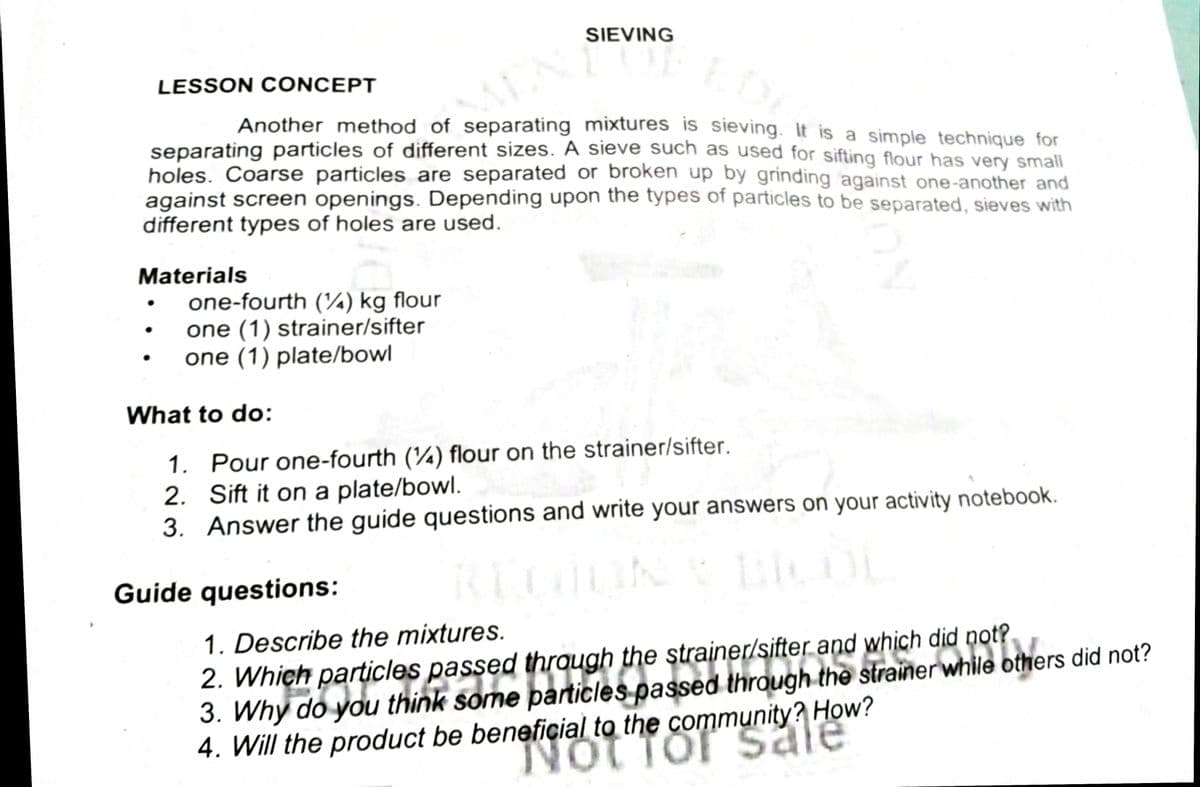LESSON C ONCEPT Another method of separating mixtures is sieving. It is a simple technique for separating particles of different sizes. A sieve such as used for sifting flour has very smal holes. Coarse particles are separated or broken up by grinding against one-another and against screen openings. Depending upon the types of particles to be separated, sieves with different types of holes are used. Materials one-fourth (¼) kg flour one (1) strainer/sifter one (1) plate/bowl What to do: 1. Pour one-fourth (4) flour on the strainer/sifter. 2. Sift it on a plate/bowl. 3. Answer the guide questions and write your answers on your activity notebook. Guide questions: REGH 1. Describe the mixtures. did not? the strainer/sifter and wwhile others did not? 2. Whieh particles passed th 3. Why do you think some particles passed through the 4. Will the product be beneficial to the community? How? Sale
LESSON C ONCEPT Another method of separating mixtures is sieving. It is a simple technique for separating particles of different sizes. A sieve such as used for sifting flour has very smal holes. Coarse particles are separated or broken up by grinding against one-another and against screen openings. Depending upon the types of particles to be separated, sieves with different types of holes are used. Materials one-fourth (¼) kg flour one (1) strainer/sifter one (1) plate/bowl What to do: 1. Pour one-fourth (4) flour on the strainer/sifter. 2. Sift it on a plate/bowl. 3. Answer the guide questions and write your answers on your activity notebook. Guide questions: REGH 1. Describe the mixtures. did not? the strainer/sifter and wwhile others did not? 2. Whieh particles passed th 3. Why do you think some particles passed through the 4. Will the product be beneficial to the community? How? Sale
Introductory Chemistry: A Foundation
9th Edition
ISBN:9781337399425
Author:Steven S. Zumdahl, Donald J. DeCoste
Publisher:Steven S. Zumdahl, Donald J. DeCoste
Chapter3: Matter
Section: Chapter Questions
Problem 5CR
Related questions
Question
Im just on 6th grade pls answer the question simple. Thank u so much hope u could help me thank you ❤❤❤❤

Transcribed Image Text:s passed through the strainer/sifter anu while others did not?
SIEVING
LESSON CONCEPT
Another method of separating mixtures is sieving. It is a simple technique for
separating particles of different sizes. A sieve such as used for sifting flour has very small
holes. Coarse particles are separated or broken up by grinding against one-another and
against screen openings. Depending upon the types of particles to be separated, sieves with
different types of holes are used.
Materials
one-fourth (¼) kg flour
one (1) strainer/sifter
one (1) plate/bowl
What to do:
1. Pour one-fourth (¼) flour on the strainer/sifter.
2. Sift it on a plate/bowl.
3. Answer the guide questions and write your answers on your activity notebook.
Guide questions:
1. Describe the mixtures.
2. Which particles passed through the strainer/sifter and which dịd not?
3. Why do you think some particles passed through the strainer while others did not?
4. Will the product be beneficial to the community? How?
NoT Tor sa
Expert Solution
This question has been solved!
Explore an expertly crafted, step-by-step solution for a thorough understanding of key concepts.
This is a popular solution!
Trending now
This is a popular solution!
Step by step
Solved in 3 steps

Knowledge Booster
Learn more about
Need a deep-dive on the concept behind this application? Look no further. Learn more about this topic, chemistry and related others by exploring similar questions and additional content below.Recommended textbooks for you

Introductory Chemistry: A Foundation
Chemistry
ISBN:
9781337399425
Author:
Steven S. Zumdahl, Donald J. DeCoste
Publisher:
Cengage Learning

World of Chemistry, 3rd edition
Chemistry
ISBN:
9781133109655
Author:
Steven S. Zumdahl, Susan L. Zumdahl, Donald J. DeCoste
Publisher:
Brooks / Cole / Cengage Learning

Chemistry: Principles and Practice
Chemistry
ISBN:
9780534420123
Author:
Daniel L. Reger, Scott R. Goode, David W. Ball, Edward Mercer
Publisher:
Cengage Learning

Introductory Chemistry: A Foundation
Chemistry
ISBN:
9781337399425
Author:
Steven S. Zumdahl, Donald J. DeCoste
Publisher:
Cengage Learning

World of Chemistry, 3rd edition
Chemistry
ISBN:
9781133109655
Author:
Steven S. Zumdahl, Susan L. Zumdahl, Donald J. DeCoste
Publisher:
Brooks / Cole / Cengage Learning

Chemistry: Principles and Practice
Chemistry
ISBN:
9780534420123
Author:
Daniel L. Reger, Scott R. Goode, David W. Ball, Edward Mercer
Publisher:
Cengage Learning

Chemistry for Today: General, Organic, and Bioche…
Chemistry
ISBN:
9781305960060
Author:
Spencer L. Seager, Michael R. Slabaugh, Maren S. Hansen
Publisher:
Cengage Learning